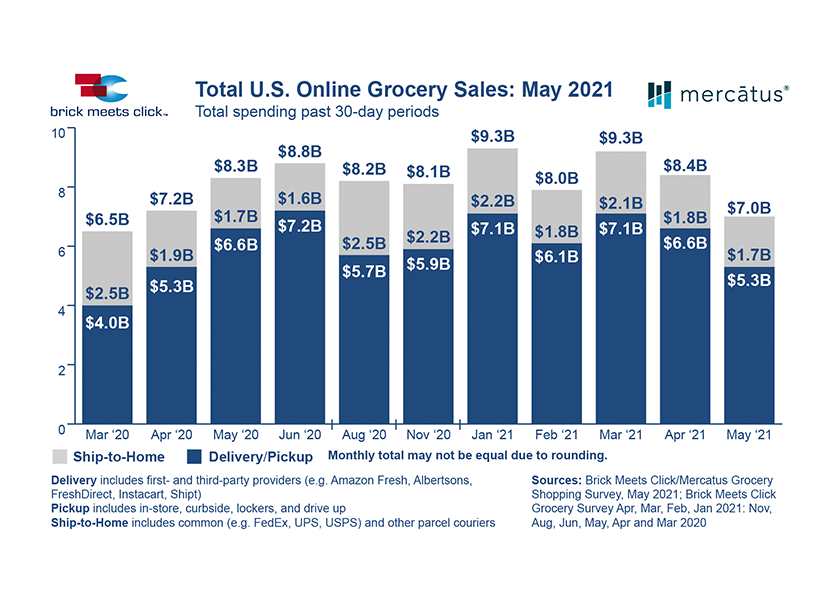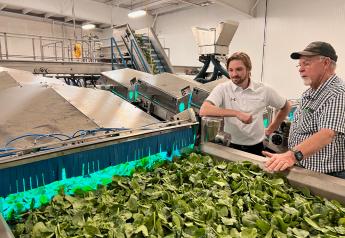Retailers, analysts point to impulse as untapped opportunity for produce online

Total online grocery sales in May were 3.5 times higher than pre-pandemic levels, totaling $7.0 billion, according to the latest report from retail consulting firm Brick Meets Click.
“As the business laps very tough year-over-year comparisons, it is essential to put monthly performance into perspective and keep an eye on the big picture,” David Bishop, partner in Brick Meets Click, which specializes in the convergence of physical and digital retail, said in a news release. “May’s results show the market retains 70% of the incremental gains generated versus the record COVID high of $9.3 billion, illustrating that much of the gain propelled by the pandemic has stuck around.”
Retail perspective
Produce retail leaders generally report that fresh produce is popular in online orders, even as many see opportunities for improvement in the digital shopping experience.
Price Mabry, director of produce and floral for Oklahoma City-based HAC Inc., said the priority right now for online is getting the fundamentals right. Upselling and cross-merchandising are on the horizon.
Jeff Cady, director of produce and floral for Williamsville, N.Y.-based Tops Markets, also noted that the online environment just isn’t optimized for sales yet the way the in-store environment is.
“I have my personal preference what I want folks to do because I think digitally we’re still in the infancy,” Cady said. “I think cross-merchandising and those extra sales are still a challenge, and I think there’s a lot of upside, but I’d much rather have their feet in the store because I feel I can sell them stuff. Right now it’s not right where we want it to be.”
For years there was widespread skepticism about whether consumers would want to buy produce online. Now it is apparent that many are willing to do so.
“I know a few of my colleagues had the same thought (as me) that nobody’s really going to buy a lot of produce on there because they want to pick it out themselves,” said Mike Roberts, director of produce for Springdale, Ark.-based Harps Food Stores. “Well, I was wrong on that, 100%.
"Actually produce is one of the most-picked items on there," Roberts said. "I think we’re second after grocery, so the consumer definitely trusts the selectors. It’s going to continue to grow.”
Michael Schutt, director of produce and floral for West Sacramento, Calif.-based Raley’s, was similarly unconvinced of buying produce online in the early days. More recently, however, Schutt has bought fresh items online himself – sort of his own miniature case study on whether discerning shoppers are getting their needs met through the company’s online platform.
“I really don’t have any complaints, and I think that probably I’m not the minority in this, so I think a percentage of it’s going to be here to stay,” Schutt said.
Analyst outlook
Jonna Parker, principal for the IRI Fresh Center of Excellence, predicted a big future for produce online in a recent education session hosted by the United Fresh Produce Association.
“The only thing holding us back is how we merchandise it,” Parker said. “Ten years from now, we’ll look back at how we sold fresh foods and total food and beverage online and laugh at how archaic it was – the way we laughed at ‘Why would I ever need a smartphone?’ or ‘Why would I ever text?’ …
"We are only at the tip of the iceberg," Parker said, "and we need to go back to how consumers want to buy these foods.”
She described selling meal solutions as the broader opportunity across physical and digital grocery retail. Conducting co-purchase analysis to identify and promote adjacencies – products frequently bought together – can help retailers meet consumer demand for meal solutions and increase sales also.
One example she gave: When a shopper is adding hunks of specialty cheese to a cart, the website or app should produce a prompt that says, “Looks like you’re having a party – here are some suggestions!” and list a produce party platter or other items that would be complementary to the items already in the cart.
This is a common practice elsewhere in online retail. Amazon, for instance, is well known for its “People who bought this item also bought …” module that encourages incremental purchases.
Parker suggested that grocery look to industries like apparel, travel and non-edibles for inspiration on how to improve the online shopping experience.
“That is our future, and I do think we’re going see strong growth, but we have to get there by bringing new people to the party,” Parker said.
She noted that refining search would be one way to make the online produce shopping more user-friendly. Currently, searching for a sandwich might produce a nice deli option … or frozen Uncrustables. Searching for a salad will turn up bagged salads but often triggers less relevant items as well.
“These categories, retailers are just throwing things up there based on their total distribution and total (assortment) that they’re carrying today, and therefore it is the Wild West as a consumer to try to shop for these,” Parker said. “Imagine a different experience. Imagine if we put the thought, energy and effort, even just 10% of that that we put into the in-store experience in the online shopping experience for produce and deli convenience food. It would be game-changing.”







